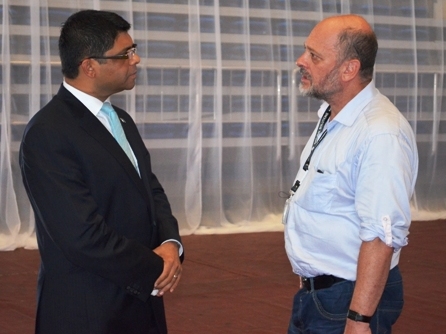
Island and Ocean Ecosystems
By Shahani Mala, a journalism student at the Fiji National University
2 December 2013, Suva Fiji - A world renowned scientist has told a Pacific Island gathering on nature conservation in Suva, Fiji that the evidence of climate change is overwhelming and clear and that this was the critical decade to take decisive action.
Dr Tim Flannery says we are already seeing the social, economic and environmental impacts of a changing climate.
In his presentation to the Pacific Islands Conference on Nature Conservation and Protected Areas, Dr Flannery said "it is beyond reasonable doubt that the burning of fossil fuels is the primary cause".
"Decisions we make from now to 2020 will determine the severity of climate change our children and grandchildren experience," Dr Flannery added.

The director of the Australian Climate Council shared evidence on how climate change was having an impact in Australia.
"The hottest month recorded for Australia was on 7 January 2013," said Dr Flannery during his presentation this morning.
The average daily maximum temperature for the whole of Australia was over 39 degrees Celsius for seven consecutive days from the 2-8 January 2013, Flannery noted.
He said severe heatwaves occurred across 70 per cent of Australia in late December 2012 and early January 2013.
Dr Flannery made reference to the floods in Queensland in December 2010, where 300,000 homes and businesses lost power in Brisbane and Ipswich.
Major bush fires in Australia is also being attributed in part to climate change.
"Climate change exacerbates bushfire conditions by increasing the frequency of very hot days," said Dr Flannery.
He provided evidence that between 1973 and 2010 the Forest Fire Danger Index increased significantly at 16 of 38 weather stations across Australia, mostly in the southeast. None of the stations showed a significant decrease.
"Projected increases in hot days across Australia, and in dry conditions in the southwest and southeast, will very likely lead to more days with extreme fire danger in those regions," said Dr Flannery.
Shahani Mala is a member of the Media Team providing coverage of the 9th Pacific Islands Conference on Nature Conservation and Protected Areas from 2 to 6 December in Suva, Fiji. This is a partnership between the Fiji National University (FNU), University of the South Pacific (USP), SPREP and Pacific Isalnds News Association (PINA) whereby a team of 10 journalism students are mentored by senior reporters as they cover the conference. This activity is funded by the Pacific Assistance Media Scheme.
2 December 2013, Suva Fiji - A world renowned scientist has told a Pacific Island gathering on nature conservation in Suva, Fiji that the evidence of climate change is overwhelming and clear and that this was the critical decade to take decisive action.
Dr Tim Flannery says we are already seeing the social, economic and environmental impacts of a changing climate.
In his presentation to the Pacific Islands Conference on Nature Conservation and Protected Areas, Dr Flannery said "it is beyond reasonable doubt that the burning of fossil fuels is the primary cause".
"Decisions we make from now to 2020 will determine the severity of climate change our children and grandchildren experience," Dr Flannery added.

The director of the Australian Climate Council shared evidence on how climate change was having an impact in Australia.
"The hottest month recorded for Australia was on 7 January 2013," said Dr Flannery during his presentation this morning.
The average daily maximum temperature for the whole of Australia was over 39 degrees Celsius for seven consecutive days from the 2-8 January 2013, Flannery noted.
He said severe heatwaves occurred across 70 per cent of Australia in late December 2012 and early January 2013.
Dr Flannery made reference to the floods in Queensland in December 2010, where 300,000 homes and businesses lost power in Brisbane and Ipswich.
Major bush fires in Australia is also being attributed in part to climate change.
"Climate change exacerbates bushfire conditions by increasing the frequency of very hot days," said Dr Flannery.
He provided evidence that between 1973 and 2010 the Forest Fire Danger Index increased significantly at 16 of 38 weather stations across Australia, mostly in the southeast. None of the stations showed a significant decrease.
"Projected increases in hot days across Australia, and in dry conditions in the southwest and southeast, will very likely lead to more days with extreme fire danger in those regions," said Dr Flannery.
Shahani Mala is a member of the Media Team providing coverage of the 9th Pacific Islands Conference on Nature Conservation and Protected Areas from 2 to 6 December in Suva, Fiji. This is a partnership between the Fiji National University (FNU), University of the South Pacific (USP), SPREP and Pacific Isalnds News Association (PINA) whereby a team of 10 journalism students are mentored by senior reporters as they cover the conference. This activity is funded by the Pacific Assistance Media Scheme.